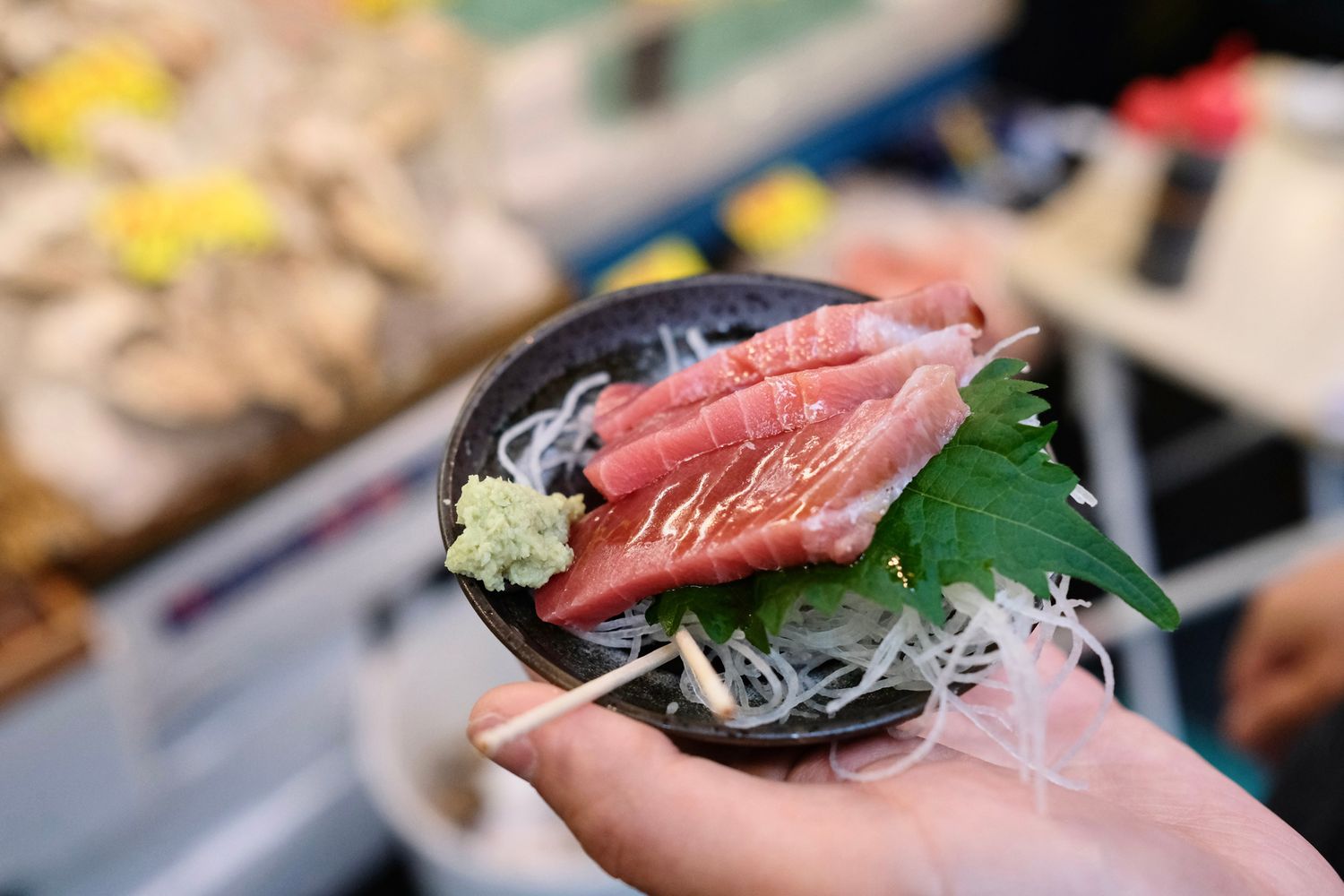:max_bytes(150000):strip_icc():format(jpeg)/TAL-lead-image-TSUKIJIMARKET0725-f808ea41d71e48cc82fb365a3a6ca0a0.jpg)
- Tsukiji Market is Japan’s oldest and most famous fish market, and is best known for the unique meals visitors can have here.
- The wholesale tuna portion of the market moved to Toyosu, but Tsukiji still thrives with shops, restaurants, and the new Uogashi market.
- In addition to great meals, visitors can also shop for premium kombu and matcha, and even visit a shrine honoring the seafood that fuels the nation.
Visiting a seafood market is an essential part of any trip to Japan, and Tokyo’s Tsukiji Market is the grandfather of them all.
Eating fatty tuna freshly sliced from a fish the size of a motorcycle, sampling deep-sea creatures you’ve never heard of, and taking a deep dive into the staples of Japanese cuisine are just some of the pleasures it offers. You may have heard that the wholesale fish market has moved to Toyosu (less than two miles away), but that’s not the full story. Tsukiji still has plenty to enjoy.
Tsukiji, located just south of Ginza’s glittery retail mecca, has a history that stretches back to 1657, when a huge fire tore through Tokyo (known as “Edo” back then). During rebuilding efforts, the shogunate decided to reclaim some coastal land at the mouth of the Sumida River. This reclaimed land became Tsujiki, and it was originally intended to be a quiet residential area.
However, another disaster, a massive earthquake in 1923, transformed Tsukiji into a commercial district. The Nihonbashi Fish Market (the busiest fish market in Tokyo before Tsukiji) was destroyed, so vendors relocated to Tsukiji, attracted by its access to Tokyo Bay. The Tsukiji Fish Market officially opened for business in 1935 and was at one point the largest wholesale market in the world.
As Tokyo boomed in the 1980s, the narrow aisles and lack of refrigeration put the aging market under new pressures and strain. A new facility was built in nearby Toyosu for wholesale operations, including the popular predawn tuna auctions, and Tsukiji’s “inner market” was torn down in 2018.
However, the outer market, a warren of retail stalls and restaurants, cropped up around the former wholesale grounds and is still going strong. In fact, a new hybrid retail and wholesale market called Tsukiji Uogashi was recently built to sustain this historic neighborhood, staffed by many of the old market vendors.
To give us the lay of the land, we asked Kyoko Nagano, CEO of cultural tourism operator Mypal.jp and director of sake export and tour company Sake Lovers to share some of her favorite places in Tsukiji. Her first piece of advice? Don’t forget the market still runs on the old-school schedule, with shops mostly open in the morning and early afternoon and closed on Sundays, Wednesdays, and holidays.
Here’s what you need to know before planning a visit to Tsukiji Fish Market.
Best Things to Eat
Angelina Pilarinos/Travel + Leisure
Food is naturally the main attraction in Tsukiji.
Nagano says if you are coming for a sushi breakfast or lunch, the best bet is the Uogashi Yokocho rather than the sit-down restaurants outside. Uogashi is located on the fourth floor of the Fisheries Intermediate Wholesale Market Building, and you can find around 70 specialty restaurants and shops there.
“The tuna vendors have fantastic visit (tuna) nigiri, and it’s only (around) 1,000 yen for six pieces,” she says. “Other places charge more than double that.”
Nagono recommends visiting wholesaler Kitani Suisan in particular. “Sometimes, if you come around like 8:30 or 9:00 am, you actually get to see the tuna cutting,” she says. “And if you are buying the tuna, they let you take photos of the tuna, too.”
After that, simply take your purchases to the rooftop dining space, where free chopsticks and soy sauce are provided, and enjoy a budget-priced comparison of all the different tuna cuts.
However, the outer market restaurants are still worth a look and Nagano suggests stopping by Sushi Yamaharua hidden, reservations-only sushi restaurant directly run by a market vendor. “It’s 5,500 yen for an omakase sushi courseand that’s so affordable,” she says. “I would say it’s one of the best.”
If raw fish isn’t your speed, there’s Unagi Shokudoa grilled eel specialist. They offer the classic eel rice bowl, but also specialize in hitsumabushia serving style popular in Nagoya that involves topping the eel with green onions, wasabi, and Japanese parsley and pouring dashi over it all.
Beef fans, meanwhile, should make a beeline for Wine Stand 88a tiny counter shop that sells roast wagyu sandwiches. “Their wagyu is cooked on the grill and pretty thick, but they only serve like 10 (sandwiches) per day,” says Nagano. “My absolute favorite is their roast beef with uni (sea urchin) as a topping. They put a generous amount of uni on top. It’s a really amazing combo.”
For dessert, Nagano recommends stopping by confectionary Soratsukiwhich specializes in daifuku mochi, or mochi stuffed with sweet beans. Consider getting their strawberry daifuku, which aren’t just pretty to look at—they’re delicious, too.
Best Places to Shop
PHILIP FONG/AFP via Getty Images
Once your belly is full, there’s plenty of shopping to be had in the area, especially if you’re in the mood for browsing for Japanese specialty ingredients.
Nagano recommends visiting Kotobukiyaa dashi stock specialist founded in 1948. “The older gentleman who runs the shop is so knowledgeable about the fermentation of Kombu (an edible kelp),” she says. “(Young) kombu has a slimy texture because it’s so new, but if it’s aged for 10 or 20 years, the sweetness comes out. It gets white with pale, dusty stuff. But that’s what gives it more umami and sweetness. A lot of Michelin chefs like to get it there.”
For matcha and other green teas, there’s Jugetsudo Tea Housefounded in 1854. “They have a lot of teas from Fukuoka, a lot from Kyoto, like organic ones from Uji, all sold as single-origin teas. But I particularly love the matcha cookies with hazelnuts,” says Nagano.
If you want to try some teas before you buy them, they do have a cafe counter. However, Nagano recommends visiting their Kengo Kuma-designed Ginza cafesited just a few blocks north. It’s above the Kabuki-for Theaterand is frequently visited by elegant ladies in kimonos headed to kabuki performances.
Best Things to Do
LilyRosePhotos/Adobe Stock
While food is certainly Tsukiji’s main attraction, we’d be remiss if we didn’t mention the historic Namiyoke Inaria Shinto shrine that dates back to Tsukiji’s earliest years, way back to 1659. Its name literally means “protection from the waves,” and the fishers who stock the market have long visited to pray for the safety of their boats and crews. Interestingly, the shrine also has monuments honoring the sea life that gets turned into the seafood that sustains Japan. So, offer a grateful bow at the sushi grave before heading out for more omakase.





